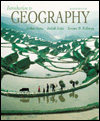 |  Introduction to Geography, 8/e Arthur Getis,
San Diego State University
Judith Getis
Jerome D. Fellmann,
University of Illinois, Urbana-Champaign
Physical Geography: Weather and Climate
Objectives:After reading and studying this chapter you should be able to:
1.
Distinguish between weather and climate.
|
 |  |  | 2.
Understand the role of the sun in supplying energy to the earth and how solar insolation varies by
latitude and time of the year; understand the components of the earth's solar energy budget.
|
 |  |  | 3.
Understand the lapse rate and its deviations. Calculate the temperature at any elevation by using it.
|
 |  |  | 4.
Understand the relationship between temperature, atmospheric pressure and winds.
|
 |  |  | 5.
Understand the Coriolis Force and the Frictional Effect, and how both influence wind belts on the earth's
surface.
|
 |  |  | 6.
Understand the importance of oceans, ocean temperature and ocean currents in relation to climate formation and change.
|
 |  |  | 7.
Identify the various forms of precipitation and note under what conditions they are likely to occur.
|
 |  |  | 8.
Understand the soil formation process.
|
 |  |  | 9.
Understand the interrelationship between climate soil and natural vegetation.
|
 |  |  | 10.
Identify the major climate regions using the Koppen climate classification system of temperature and precipitation and by their associated characteristics of natural vegetation and soils.
|
 |  |  | 11.
Interpret climagraphs. Understand how to construct a climagraph from statistical information.
|
 |  |  | 12.
Label a map of the world's climate distribution.
|
|



 2002 McGraw-Hill Higher Education
2002 McGraw-Hill Higher Education